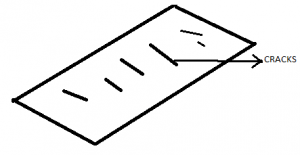This set of Forming Questions and Answers for Freshers focuses on “Defects in Rolled Parts”.
1. Which of the following cannot be regarded as a defect in rolled parts?
a) Inhomogeneous deformation
b) Surface defect
c) External cracking defect
d) Internal structure defect
View Answer
Explanation: Among the following defects in rolled parts, external cracking defect cannot be termed as a defect in rolled parts.
2. Which of the following cannot be regarded as an internal structure defect?
a) Edge crack
b) Zipper cracks
c) Alligatoring
d) Quevering
View Answer
Explanation: Among the following internal structure defects, quevering is not any kind of a defect which can be regarded as an internal structure defect.
3. Which of the following defect occurs because of the bending of rolls?
a) Zipper cracks
b) Folds
c) Laminations
d) Alligatoring
View Answer
Explanation: Wavy edges and zipper cracks can occur as defects in the material, if the rolls are bended, but not, folds or laminations or alligatoring. Their causes of occurrence are different.
4. Which defect takes place if the reduction per mass is very low?
a) Zipper cracks
b) Folds
c) Laminations
d) Alligatoring
View Answer
Explanation: Folds are found to occur during the plate rolling if the reduction per mass is very low. And zipper cracks occur when the given rolls get bended.
5. Incomplete welding may cause which of the following defect?
a) Folds
b) Laminations
c) Wavy edges
d) Zipper cracks
View Answer
Explanation: Because of incomplete welding in the blow holes and the pipes, small laminations occur, causing the strength of the material to reduce.
6. Which defect is rupturing of sheet and following the roller path?
a) Folds
b) Laminations
c) Alligatoring
d) Wavy edges
View Answer
Explanation: When the material is compressed against the rolls, the sheet may get ruptured, without laterally, the width getting converted to length. Such a defect is called as alligatoring.
7. In hot rolling, the temperature of working is uniform.
a) True
b) False
View Answer
Explanation: In hot working processes, the temperature at which the work takes place is not uniform. There is change of temperature that takes place in between the process when it is going on.
8. In which of the following defects is a crown formed?
a) Wavy edges
b) Alligatoring
c) Folds
d) Laminations
View Answer
Explanation: A crown shape gets formed by the material, due to rolling loads. Crowns get formed in wavy edge defect.
9. The following figure represents which defect?

a) Alligatoring
b) Zipper cracks
c) Folds
d) Laminations
View Answer
Explanation: The following figure depicts in itself the defect, this crack is called as zipper cracks. A defect like zipper crack may occur when the rolls which are employed for it, get bended.
10. While rolling, material near the edges experience compression.
a) True
b) False
View Answer
Explanation: While rolling, due to the metal being continuous, the material present near the edges, experiences tensile force, that is a pulling force, and not pushing or a compression force.
Sanfoundry Global Education & Learning Series – Forming.
To practice all areas of Forming for Freshers, here is complete set of 1000+ Multiple Choice Questions and Answers.
If you find a mistake in question / option / answer, kindly take a screenshot and email to [email protected]
- Check Mechanical Engineering Books
- Practice Metallurgical Engineering MCQs
- Practice Mechanical Engineering MCQs
- Apply for Metallurgical Engineering Internship
- Practice Casting, Forming and Welding I MCQ
